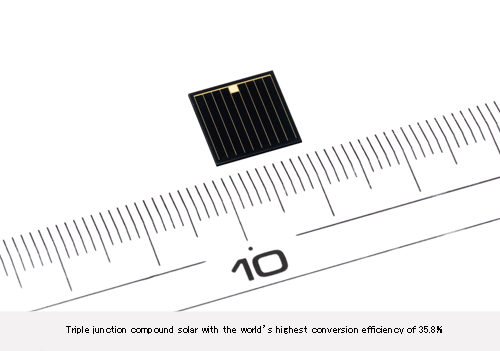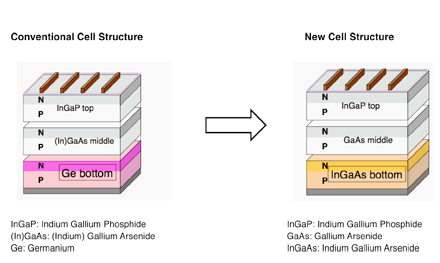
Sharp Corporation has achieved the world’s highest solar cell conversion efficiency*1 of 35.8%*2 using a triple-junction compound solar cell.
Unlike silicon-based solar cells, the most common type of solar cell in use today, the compound solar cell utilizes photo-absorption layers made from compounds consisting of two or more elements such as indium and gallium. Due to their high conversion efficiency, compound solar cells are used mainly on space satellites. Since 2000, Sharp has been advancing research and development on a triple-junction compound solar cell that achieves high conversion efficienc y by stacking three photo-absorption layers.
To boost the efficiency of triple-junction compound solar cells, it is important to improve the crystallinity (the regularity of the atomic arrangement) in each photo-absorption layer (the top, middle, and bottom layer). It is also crucial that the solar cell be composed of materials that can maximize the effective use of solar energy.
Conventionally, Ge (germanium) is used as the bottom layer due to its ease of manufacturing. However, in terms of performance, although Ge generates a large amount of current, the majority of the current is wasted, without being used effectively for electrical energy. The key to solving this problem was to form the bottom layer from InGaAs (indium gallium arsenide), a material with high light utilization efficiency. However, the process to make high-quality InGaAs with high crystallinity was difficult.
Sharp has now succeeded in forming an InGaAs layer with high crystallinity by using its proprietary technology for forming layers. As a result, the amount of wasted current has been minimized, and the conversion efficiency, which had been 31.5% in Sharp’s previous cells, has been successfully increased to 35.8%.
Sharp achieved this breakthrough as part of a research and development initiative promoted by Japan’s New Energy and Industrial Technology Development Organization (NEDO)*3 on the theme of “R&D on Innovative Solar Cells”.
Based on these results, Sharp will continue its efforts toward even greater improvements in solar cell conversion efficiency.

History of Sharp Compound Solar Cell Development
| 1967 |
Development begins of solar cells for space applications using single-crystal silicon. |
| 1976 |
Launch of operational Japanese satellite, “Ume,” equipped with Sharp solar cells for space applications (single-crystal silicon solar cell). |
| 2000 |
Research and development begin on triple-junction compound solar cell to further improve efficiency, reduce weight, and increase durability of solar cells for space applications. |
| 2001 |
Participation in research and development on NEDO’s photovoltaic power generation themes. |
| 2002 |
Triple-junction compound solar cell gains certification from the Japan Aerospace Exploration Agency (JAXA). |
| 2003 |
Conversion efficiency of 31.5% is achieved (at the research level) for triple-junction compound solar cell. |
| 2004 |
Launch of small scientific satellite, “Reimei,” equipped with Sharp triple-junction compound solar cells. |
| 2007 |
Conversion efficiency of 40.0% achieved (at the research level) for a triple-junction compound solar cell (concentrator type, at 1,100 times concentrated sunlight). |
| 2009 |
Launch of Greenhouse gases Observing SATellite (GOSAT), “Ibuki”, equipped with Sharp triple-junction compound solar cells. |
| 2009 |
Conversion efficiency of 35.8% is achieved (at the research level) for a triple-junction compound solar cell based on research and development efforts that are part of NEDO’s “R&D on Innovative Solar Cells” program. |
| *1 |
As of October 22, 2009, for non-concentrator solar cells at the research level (based on Sharp survey). |
| *2 |
Conversion efficiency confirmed by the National Institute of Advanced Industrial Science and Technology (AIST; one of the organizations around the world that officially certifies energy conversion efficiency measurements in solar cells) in September 2009. (Cell surface: approx. 1 cm2) |
| *3 |
The New Energy and Industrial Technology Development Organization (NEDO) is Japan’s public management organization for promoting rese arch and development as well as for disseminat ing industrial, energy, and environmental technologies. |
| The above information is true and accurate at the time of publication. Manufacture, sale, price and specifications of products may be subject to change. |
|